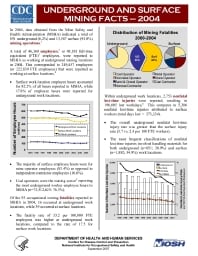Mining Publication: Underground and Surface Mining Facts - 2004
Original creation date: September 2007
Authors: National Institute for Occupational Safety and Health
NIOSHTIC2 Number: 20032734
Pittsburgh, PA: U.S. Department of Health and Human Services, Public Health Service, Centers for Disease Control and Prevention, National Institute for Occupational Safety and Health, DHHS (NIOSH) Publication No. 2007-174, 2007 Sep; :1-2
In 2004, data obtained from the Mine Safety and Health Administration (MSHA) indicated a total of 891 underground (6.2%) and 13,587 surface (93.8%) mining operations. A total of 46,360 employees, or 48,183 full-time equivalent (FTE) employees, were reported to MSHA as working at underground mining locations in 2004. This corresponded to 249,457 employees (or 222,839 FTE employees) that were reported as working at surface locations. Surface work location employee hours accounted for 82.2% of all hours reported to MSHA, while 17.8% of employee hours were reported for underground work locations. The majority of surface employee hours were for mine operator employees (83.4%) as opposed to independent contractor employees (16.6%). Coal operators were the mining sector reporting the most underground worker employee hours to MSHA (n=73,512,625; 76.3%). Of the 55 occupational mining fatalities reported to MSHA in 2004, 16 occurred at underground work locations, while 39 occurred at surface locations. The fatality rate of 33.2 per 100,000 FTE employees was higher at underground work locations, compared to the rate of 17.5 for surface work locations. Within underground work locations, 2,753 nonfatal lost-time injuries were reported, resulting in 190,005 lost workdays. This compares to 5,386 nonfatal lost-time injuries attributed to surface workers (total days lost = 273,334). The overall underground nonfatal lost-time injury rate was greater than the surface injury rate (5.7 vs. 2.4 per 100 FTE workers). The most frequent classifications of nonfatal lost-time injuries involved handling materials for both underground (n=851; 30.9%) and surface (n=1,882; 34.9%) work locations. The back was the most frequently reported part of the body injured at both underground (n=536; 19.5%) and surface (n=1,163; 21.6%) work locations. These back injuries accounted for 47,191 days lost from work at underground work locations and 63,271 days lost at surface locations in 2004. In 2004, 167 cases of occupational illnesses were reported at underground work locations. This compares to 259 cases reported for surface locations. The majority of the reported illness cases were for joint, tendon, or muscle inflammation or irritation for both underground (n=81; 48.5%) and surface (n=115; 44.4%) work locations.

NIOSHTIC2 Number: 20032734
Pittsburgh, PA: U.S. Department of Health and Human Services, Public Health Service, Centers for Disease Control and Prevention, National Institute for Occupational Safety and Health, DHHS (NIOSH) Publication No. 2007-174, 2007 Sep; :1-2